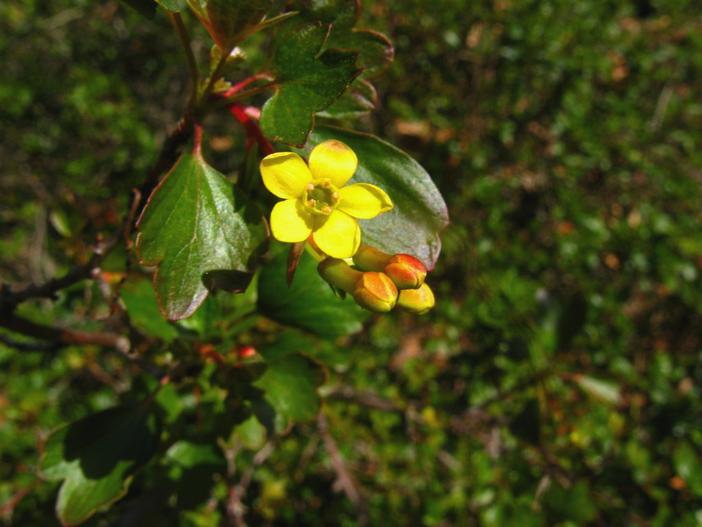Golden Currant
(Ribes aureum var. gracillimum)
Golden Currant (Ribes aureum var. gracillimum)
/
/

John Rusk
CC BY 2.0
Image By:
John Rusk
Recorded By:
Copyright:
CC BY 2.0
Copyright Notice:
Photo by: John Rusk | License Type: CC BY 2.0 | License URL: https://creativecommons.org/licenses/by/2.0/ | Uploader: John Rusk | Publisher: Flickr




Estimated Native Range
Summary
Ribes aureum var. gracillimum, commonly known as Golden Currant or Buffalo Currant, is a deciduous shrub native to a variety of habitats in Western North America, including open woodlands, along streams, and on prairie hillsides. It is particularly adaptable to riparian zones and chaparral environments. This species typically grows at a moderate rate to a height and width of 3-6 feet (0.9-1.8 meters), featuring arching branches and lobed leaves. The plant is renowned for its clusters of small, yellow, trumpet-shaped flowers that bloom in early spring, which are quite showy and often fragrant. These flowers give way to edible black or yellow berries that are attractive to wildlife and can be used in jams and jellies.
Golden Currant is valued for its drought tolerance once established, making it a suitable choice for water-wise gardens. It is also appreciated for its wildlife value, as it provides food for birds and other animals. Commonly used in naturalistic plantings, as a border shrub, or for erosion control on slopes, it can also be incorporated into hedgerows or used as a screen. Golden Currant thrives in full sun to part shade and prefers medium or fast-draining soils, including clay, loam, or sandy types. It requires moderate water but can tolerate some dryness. While generally low-maintenance, it can be susceptible to powdery mildew and rust, especially in humid conditions. Pruning after flowering can help maintain a desired shape and promote plant health.CC BY-SA 4.0
Golden Currant is valued for its drought tolerance once established, making it a suitable choice for water-wise gardens. It is also appreciated for its wildlife value, as it provides food for birds and other animals. Commonly used in naturalistic plantings, as a border shrub, or for erosion control on slopes, it can also be incorporated into hedgerows or used as a screen. Golden Currant thrives in full sun to part shade and prefers medium or fast-draining soils, including clay, loam, or sandy types. It requires moderate water but can tolerate some dryness. While generally low-maintenance, it can be susceptible to powdery mildew and rust, especially in humid conditions. Pruning after flowering can help maintain a desired shape and promote plant health.CC BY-SA 4.0
Plant Description
- Plant Type: Shrub
- Height: 3-6 feet
- Width: 3-6 feet
- Growth Rate: Moderate
- Flower Color: Yellow
- Flowering Season: Spring
- Leaf Retention: Deciduous
Growth Requirements
- Sun: Full Sun, Part Shade
- Water: Medium
- Drainage: Medium, Fast
Common Uses
Bee Garden, Bird Garden, Butterfly Garden, Edible*Disclaimer: Easyscape's listed plant edibility is for informational use. Always verify the safety and proper identification of any plant before consumption., Groundcover, Low Maintenance, Showy Flowers
Natural Habitat
Native to a variety of habitats including open woodlands, riparian zones, and chaparral environments in Western North America
Other Names
Common Names: Buffalo Currant
Scientific Names: , Ribes aureum var. gracillimum, Ribes aureum subsp. gracillimum, Ribes aureum var. gracillimum, Ribes gracillimum,
GBIF Accepted Name: